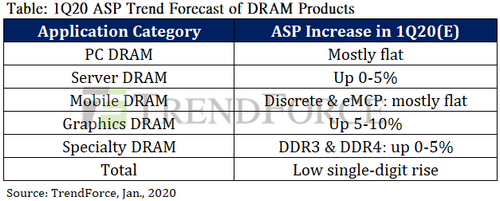DRAM Prices Not Affected by Samsung Hwaseong Fab Outage, but Will Still Rise
DRAMeXchange: it's not Samsung's fault.
On December 31, 2019, Samsung’s Hwaseong plant in South Korea suffered a one-minute long power outage. It took three days to get the DRAM plant back into production. This gave way to a few rumors that the outage would lead to increased DRAM and NAND prices, though it appears that the event won’t have any significant effects on market prices going upwards, according to a report from DRAMeXchange.
At least, the report states that the event doesn’t have an impact on the supply side of the DRAM market. Demand does appear to be rising slightly, though, which should in turn lead to slightly higher DRAM contract prices between manufacturers. According to DRAMeXchange, the upturn in prices comes a little earlier than expected, though the figures show that it is only a very slight turn of events.
The research firm said that the rise in prices won’t be due to any single event, but would simply be part of the natural cyclical market, which sees DRAM and NAND prices rise over a few years and then being followed by a few years of downfall. We’re at the end of a downfall, and DRAM and NAND prices are at an all-time low.
DRAMeXchange notes that DRAM prices, despite an upturn, won’t start skyrocketing over the first quarter of 2020, though. For some categories they will remain mostly consistent, with only server DRAM, DDR3 and DDR4 memory seeing an increase in prices between 0 and 5%. Graphics DRAM is expected to see the biggest price increase (between 5 and 10%) over the course of the next three months.

This means that if you’re in the market for an SSD such as a SATA SSD, M.2 NMVe SSD or any other form of flash storage, now is probably the time to buy. The same goes for DRAM, which you can find in DDR4 RAM but also on graphics cards.
Naturally, the rise in DRAM and NAND prices will also apply to electronics that integrate those memory products, such as pre-built PCs, laptops, tablets, phones and more. The DRAM or NAND is just a fraction of the cost in these devices, however, and the natural decline in prices that all electronics witness over time will almost certainly counter any increased DRAM costs. So there's no need to buy now.
Get Tom's Hardware's best news and in-depth reviews, straight to your inbox.
Niels Broekhuijsen is a Contributing Writer for Tom's Hardware US. He reviews cases, water cooling and pc builds.
-
Giroro Right before the most recent drop in memory prices, I had heard that China was investigating Samsung and the Triopoly for price-fixing (again).Reply
Did that investigation conclude, or is it still ongoing?
Also, does anybody know the result/status of the class action lawsuit Hagens Berman filed against the industry in 2018? -
InvalidError Up north in Canuckistan, retail memory prices have already gone up ~20% over the last month, most of which after the Samsung oopsie.Reply -
jakovasaurs "Cyclical." Call me a cynic but I wouldn't be surprised to hear about about another pittance settlement due to price-fixing in 1-3 years.Reply -
Phaaze88 I'm glad I grabbed 32GBs when Dram prices were at their lowest in ages...Reply
I should be good until GDDR5 comes. -
InvalidError Reply
GPUs use GDDR6 these days :)Phaaze88 said:I should be good until GDDR5 comes.
I'm glad I got 32GB of DDR3 on my i5 eight years ago. -
hannibal Yeah. People buy dram as much as They need.Reply
I upgraded my Computer Late last year with 64Gb of 3600 ddr4... not cheap, but I think that video editing will be much smoother than with my previous 16Gb of ddr3 :) but any normal people should still be ok with 16Gb. -
urbanman2004 ReplyGiroro said:Right before the most recent drop in memory prices, I had heard that China was investigating Samsung and the Triopoly for price-fixing (again).
Did that investigation conclude, or is it still ongoing?
Also, does anybody know the result/status of the class action lawsuit Hagens Berman filed against the industry in 2018?
I'm wondering the same thing myself. Or was it just lip service?
